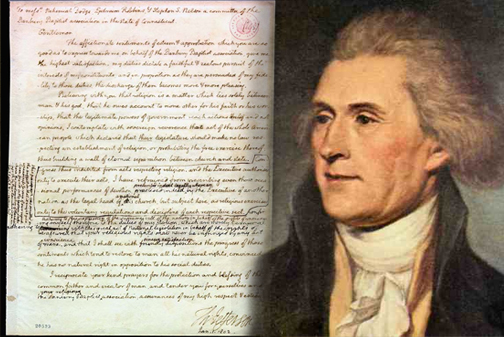Wednesday, May 4, 2016
(Updated 12/12/2025)
Jefferson's Letter To The Danbury Baptists: Marxists Use Letter To Reinterpret The Establishment Clause
In The Interests Of "The Struggle Against Religion"

The first constitutional usage of Thomas Jefferson’s infamous phrase “wall of separation between Church and State" appeared in the 1878 Supreme Court decision Reynolds v. United States, where Chief Justice Waite, delivering the court’s decision, observed that the Danbury letter “may be accepted almost as an authoritative declaration of the scope and effect of the amendment thus secured.” Since Justice Waite didn’t explain how Jefferson’s “authoritative declaration of the scope and effect of the amendment” is “secured”, this first mention by the Supreme Court of a “wall of separation between Church and State” is void of establishing a legal precedent (obiter dictum).
It would be another fifty-nine years (1947) until the Supreme Court would once again utter Jefferson’s infamous phrase, “wall of separation between Church and State”. The case Everson v. Board of Education is where we next meet the “wall”. Justice Hugo L. Black, who wrote the court’s decision, said, “In the words of Jefferson, the clause against establishment of religion by law was intended to erect "a wall of separation between Church and State… The First Amendment has erected a wall between church and state. That wall must be kept high and impregnable. We could not approve the slightest breach."
Unlike Chief Justice Waite, Justice Black gave life to the phrase “wall of separation between Church and State". The “wall” now had substance—“That wall must be kept high and impregnable. We could not approve the slightest breach." The “wall” therefore also now had legal precedent. The legal precedent isn’t, however, what proponents or opponents of the “wall” believe it to be. Incredibly, proponents of the “wall” failed to observe the problem with the new interpretation for the Establishment Clause, the problem being that a wall prevents contact from both sides of the wall! Not only does a wall prevent any church contact with the state, but conversely the wall also prevents any state contact with the church: Therefore all laws and regulations affecting religion are unconstitutional, such as prosecution of any crime by religious, payroll taxes for civilian employees of religious institutions, fire code regulations, etc.! Just as incredible, opponents of the “wall” failed to notice this obvious flaw that turns the Jefferson-based interpretation of the Establishment Clause on its head.
Even if one leaves out the word “wall” and uses instead “separation between Church and State”, we still don’t have a reason to exclude religion from any contact with the government, since separation is not the same as no contact. When conjoined twins are separated are they to have no further contact with each other? Of course not! We see then that Jefferson’s ill though out phrase, “wall of separation between Church and State” (Jefferson used the phrase in a letter, a letter that wasn’t a legal clarification on the Establishment Clause), was not meant to be used for constitutional understanding of the Establishment Clause, and that was certainly the case for Jefferson when president.
As president, Jefferson’s ideas on Federal involvement with religion witnessed his presidency endorsing Federal monies for the construction of churches and missionary work among Indians, but he passed on national religious observances. President Jefferson used religion to promote Federal goals (the Federal government has jurisdiction over Indian lands), leaving to the state legislatures to pass a day of prayer if any so wished.
The Marxist Infiltration Of The Political Establishment
The “wall of separation between Church and State" doctrine actually prevents contact from both sides of the wall, not one side only, and proponents' use of the doctrine is to bludgeon religion into submission and out of the national civil discourse. This is the initial step towards the total abolition of religion that Marx called for…
And what do we make of those who say they are against the “wall of separation between Church and State" doctrine but fail to direct our attention to the self-negating language of Jefferson’s phrase? Those 'opponents' of the doctrine are what Marxists call the false opposition, a Marxist tactic called the Scissors Strategy. Marxists utilize the tactic of employing false oppositions, more commonly referred to by Marxists as the Scissors Strategy, in which the blades represent the two falsely opposed sides that converge on the confused victims, neutralizing true opposition to socialism, thereby allowing the advancement of socialism to the bewilderment of the true opposition.
-------------------------------------------------------------------------------------
Other 'progressive' thoughts Marx has on dealing with religion...
...and...

Comments
Post a Comment